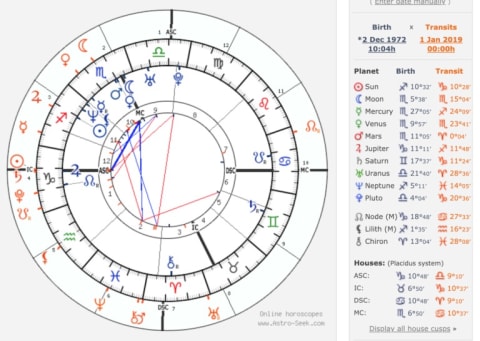For the new year, we’d suggest doing what’s called a transit chart (also called a “natal plus transits” chart). This may require the guidance of a professional astrologer because the interpretation work can get complex! In this case, you start with your own natal (birth) chart and compare it to the transiting (moving) planets, i.e., the current positions of the planets in the sky. In the example below, the inner wheel (with blue planetary symbols) is our birth chart—which is a fixed map that never changes. The orange planetary symbols in the outer wheel represent the transiting (moving) planets on January 1, 2019. A trained astrologer would compare and contrast the two charts. When a transiting (orange) planet makes contact with one of the natal (blue) planets, it activates specific energy, one that can be either opportune or challenging. Knowing this allows you to plan ahead. Transit charts aren’t only for New Year’s Day, though. You can plug in any date, past or future, and run a transit chart that compares the planets in motion to your birth chart. Transit charts are super helpful for planning. If you’re picking a wedding date, booking travel, or scheduling an important career move, check out the transit chart to see if the skies are clear. Transit charts are also great for historical perspective: You can look back at important moments in your life—new love, relocations, deaths, breakups, career coups, job losses. Do a chart (or an estimated one) to see what was happening in the stars then. If you still have questions about how to read your birth chart for max insights, check out the tutorial below:






